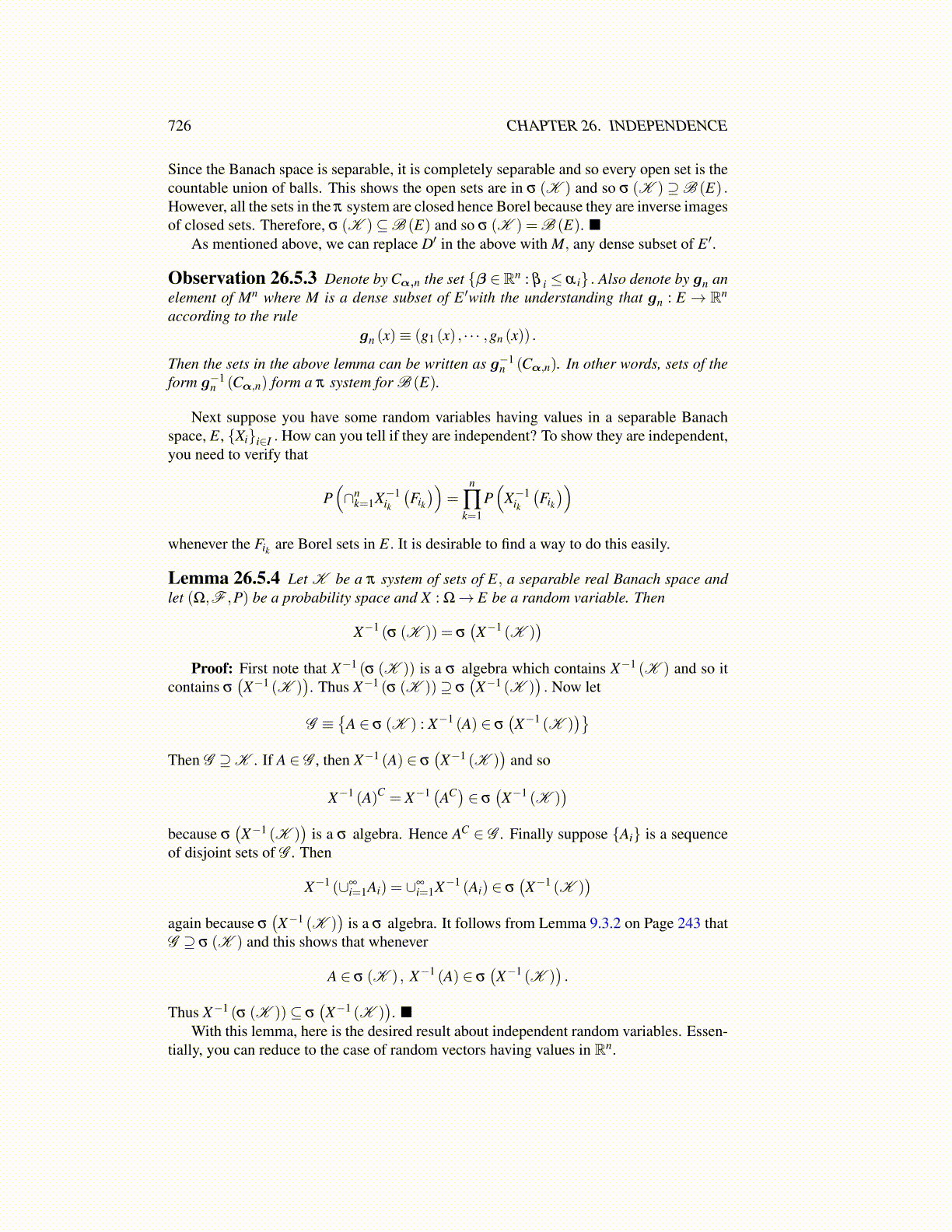
726 CHAPTER 26. INDEPENDENCE
Since the Banach space is separable, it is completely separable and so every open set is thecountable union of balls. This shows the open sets are in σ (K ) and so σ (K ) ⊇B (E) .However, all the sets in the π system are closed hence Borel because they are inverse imagesof closed sets. Therefore, σ (K )⊆B (E) and so σ (K ) = B (E). ■
As mentioned above, we can replace D′ in the above with M, any dense subset of E ′.
Observation 26.5.3 Denote by Cα,n the set {β ∈ Rn : β i ≤ α i} . Also denote by gn anelement of Mn where M is a dense subset of E ′with the understanding that gn : E → Rn
according to the rulegn (x)≡ (g1 (x) , · · · ,gn (x)) .
Then the sets in the above lemma can be written as g−1n (Cα,n). In other words, sets of the
form g−1n (Cα,n) form a π system for B (E).
Next suppose you have some random variables having values in a separable Banachspace, E, {Xi}i∈I . How can you tell if they are independent? To show they are independent,you need to verify that
P(∩n
k=1X−1ik
(Fik
))=
n
∏k=1
P(
X−1ik
(Fik
))whenever the Fik are Borel sets in E. It is desirable to find a way to do this easily.
Lemma 26.5.4 Let K be a π system of sets of E, a separable real Banach space andlet (Ω,F ,P) be a probability space and X : Ω→ E be a random variable. Then
X−1 (σ (K )) = σ(X−1 (K )
)Proof: First note that X−1 (σ (K )) is a σ algebra which contains X−1 (K ) and so it
contains σ(X−1 (K )
). Thus X−1 (σ (K ))⊇ σ
(X−1 (K )
). Now let
G ≡{
A ∈ σ (K ) : X−1 (A) ∈ σ(X−1 (K )
)}Then G ⊇K . If A ∈ G , then X−1 (A) ∈ σ
(X−1 (K )
)and so
X−1 (A)C = X−1 (AC) ∈ σ(X−1 (K )
)because σ
(X−1 (K )
)is a σ algebra. Hence AC ∈ G . Finally suppose {Ai} is a sequence
of disjoint sets of G . Then
X−1 (∪∞i=1Ai) = ∪∞
i=1X−1 (Ai) ∈ σ(X−1 (K )
)again because σ
(X−1 (K )
)is a σ algebra. It follows from Lemma 9.3.2 on Page 243 that
G ⊇ σ (K ) and this shows that whenever
A ∈ σ (K ) , X−1 (A) ∈ σ(X−1 (K )
).
Thus X−1 (σ (K ))⊆ σ(X−1 (K )
). ■
With this lemma, here is the desired result about independent random variables. Essen-tially, you can reduce to the case of random vectors having values in Rn.